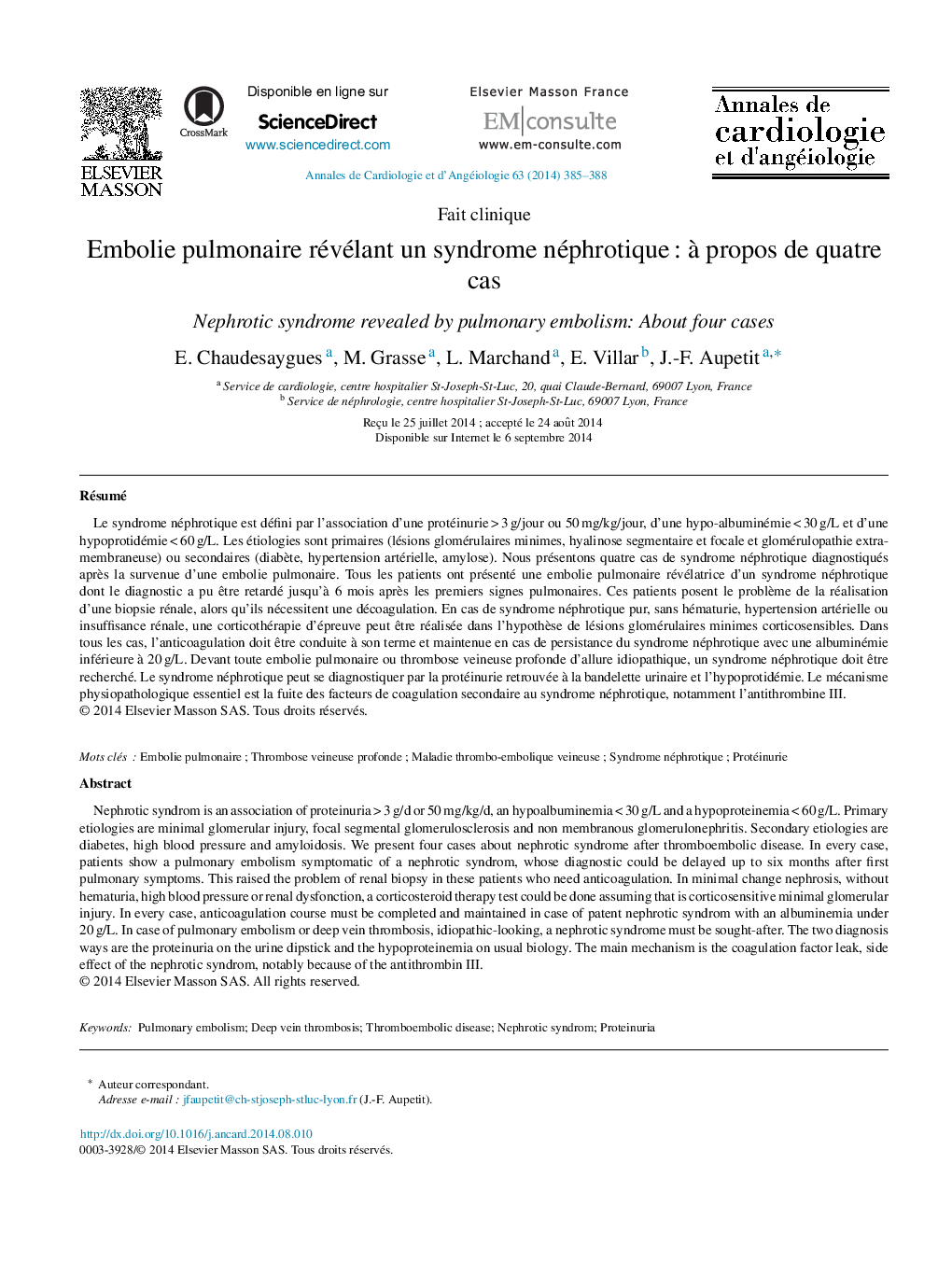| Article ID | Journal | Published Year | Pages | File Type |
|---|---|---|---|---|
| 2868705 | Annales de Cardiologie et d'Angéiologie | 2014 | 4 Pages |
RésuméLe syndrome néphrotique est défini par l’association d’une protéinurie > 3 g/jour ou 50 mg/kg/jour, d’une hypo-albuminémie < 30 g/L et d’une hypoprotidémie < 60 g/L. Les étiologies sont primaires (lésions glomérulaires minimes, hyalinose segmentaire et focale et glomérulopathie extra-membraneuse) ou secondaires (diabète, hypertension artérielle, amylose). Nous présentons quatre cas de syndrome néphrotique diagnostiqués après la survenue d’une embolie pulmonaire. Tous les patients ont présenté une embolie pulmonaire révélatrice d’un syndrome néphrotique dont le diagnostic a pu être retardé jusqu’à 6 mois après les premiers signes pulmonaires. Ces patients posent le problème de la réalisation d’une biopsie rénale, alors qu’ils nécessitent une décoagulation. En cas de syndrome néphrotique pur, sans hématurie, hypertension artérielle ou insuffisance rénale, une corticothérapie d’épreuve peut être réalisée dans l’hypothèse de lésions glomérulaires minimes corticosensibles. Dans tous les cas, l’anticoagulation doit être conduite à son terme et maintenue en cas de persistance du syndrome néphrotique avec une albuminémie inférieure à 20 g/L. Devant toute embolie pulmonaire ou thrombose veineuse profonde d’allure idiopathique, un syndrome néphrotique doit être recherché. Le syndrome néphrotique peut se diagnostiquer par la protéinurie retrouvée à la bandelette urinaire et l’hypoprotidémie. Le mécanisme physiopathologique essentiel est la fuite des facteurs de coagulation secondaire au syndrome néphrotique, notamment l’antithrombine III.
Nephrotic syndrom is an association of proteinuria > 3 g/d or 50 mg/kg/d, an hypoalbuminemia < 30 g/L and a hypoproteinemia < 60 g/L. Primary etiologies are minimal glomerular injury, focal segmental glomerulosclerosis and non membranous glomerulonephritis. Secondary etiologies are diabetes, high blood pressure and amyloidosis. We present four cases about nephrotic syndrome after thromboembolic disease. In every case, patients show a pulmonary embolism symptomatic of a nephrotic syndrom, whose diagnostic could be delayed up to six months after first pulmonary symptoms. This raised the problem of renal biopsy in these patients who need anticoagulation. In minimal change nephrosis, without hematuria, high blood pressure or renal dysfonction, a corticosteroid therapy test could be done assuming that is corticosensitive minimal glomerular injury. In every case, anticoagulation course must be completed and maintained in case of patent nephrotic syndrom with an albuminemia under 20 g/L. In case of pulmonary embolism or deep vein thrombosis, idiopathic-looking, a nephrotic syndrome must be sought-after. The two diagnosis ways are the proteinuria on the urine dipstick and the hypoproteinemia on usual biology. The main mechanism is the coagulation factor leak, side effect of the nephrotic syndrom, notably because of the antithrombin III.
